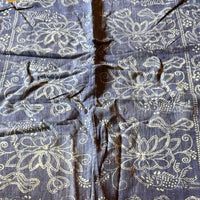

Antique Indigo Katazome Futon-ji – Floral Lattice Border Panel, 3 Panels Wide
A finely patterned antique futon-ji—a hand-sewn futon cover panel—featuring a delicate floral lattice framed by a bold arabesque border. The balanced symmetry and crisp stencil work give this piece a quiet elegance, the kind of everyday beauty found in well-made Japanese household textiles.
This cloth was patterned using katazome, a traditional Japanese resist-dye technique. Artisans brushed rice-flour paste through hand-cut stencils (katagami), allowed the paste to dry, and then dipped the cotton repeatedly into natural indigo. When the paste was rinsed away, the undyed areas revealed the repeating floral design you see here. The hand-sewn seams—three narrow loom widths joined edge-to-edge—reflect the practical, resourceful construction of rural homes during the early 20th century.
The panel shows gentle, even softening but appears to have seen light use. There are no visible patches or major flaws, making this an unusually clean example. Its clarity of pattern and minimal wear suggest it may have been part of a household’s “nicer” bedding—brought out for guests or special occasions rather than daily hard use.
Age Estimate: Antique (c. 1920–1940).
We classify this as antique based on several indicators: the hand-cut stencil patterning, natural-indigo palette, narrow hand-woven loom widths typical of pre-industrial Japanese production, and the construction method of joining three panels for a single tatami-sized cover. These features align with late Taishō to early Shōwa period textiles (Taishō: 1912–1926; early Shōwa: 1926–1945). Its crisp patterning and relatively light wear suggest careful storage over decades.
-
Indigo katazome with floral lattice field and border
-
Balanced, symmetrical patterning
-
Soft but sturdy vintage cotton
-
No visible mended patches or significant wear
Dimensions: 41" × 85.5" (104 × 217 cm)
Panels: 3 panels wide
Traditional Japanese home looms produced cloth about 13.5–14" wide. Three such widths, minus seam allowances, create a panel in the 40–42" range—consistent with this textile.
Made in Japan


